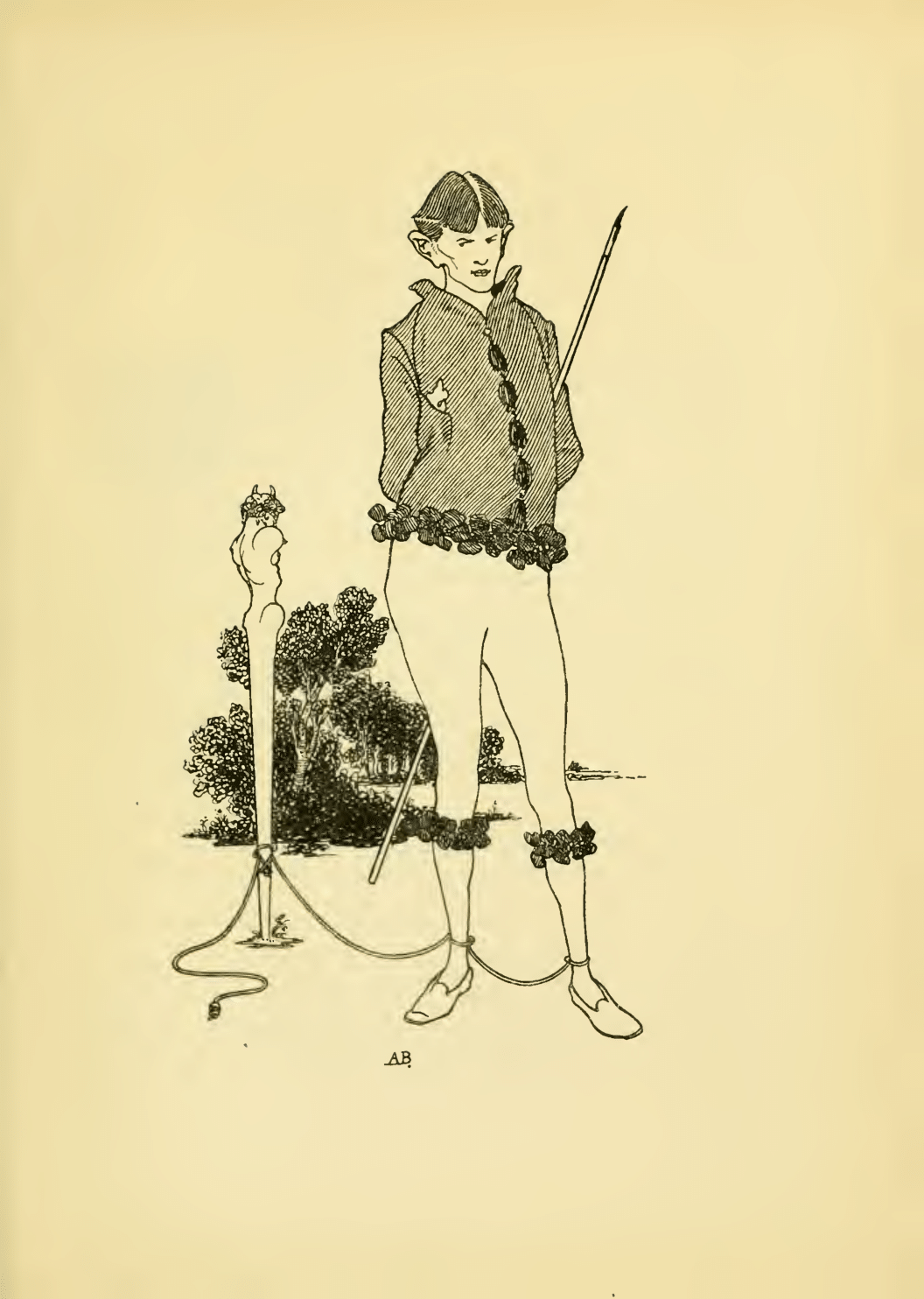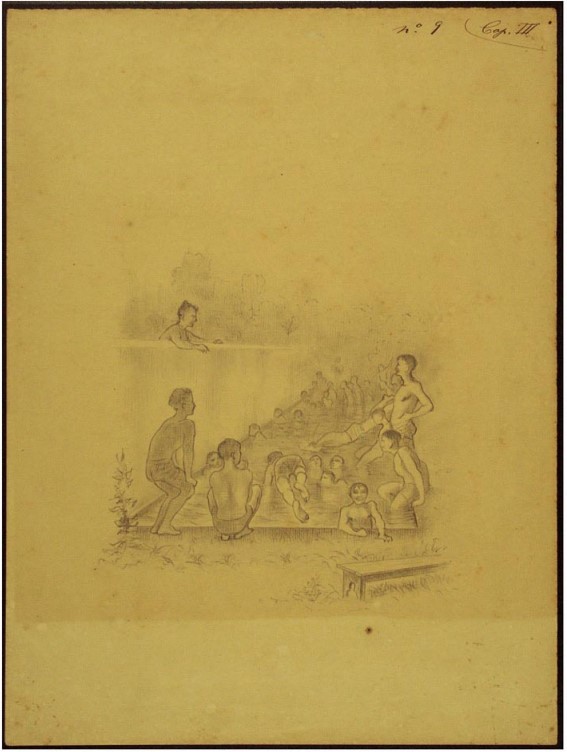
1At the end of the second issue of the periodical The Savoy (1896Smithers, Leonard (dir.). The Savoy, an Illustrated Quarterly, Leonard Smithers publisher, 1896.), publisher Leonard Smithers announced:
It is regretted that owing to Mr. Beardsley’s illness he has been unable to finish one of his full-page drawings to Chapter IV. of "Under the Hill", i.e., "The Bacchanals of Sporion", and that its publication in consequence has had to be postponed to No. 3 of "The Savoy" (1896, p. 197Beardsley, Aubrey. “Under the Hill,” dans The Savoy, Leonard Smithers publisher, 1896.).
2Unfortunately, the artist and author was unable to continue writing for The Savoy due to his illness, and the drawing “The Bacchanals of Sporion” was never published. Nevertheless, the second issue introduced the character of Sporion in a footnote to the fourth chapter — which was the last of those published in The Savoy — as well as a drawing entitled “A Footnote”.
3In this chapter, the novel’s main character, Fanfreluche, evokes some real and imaginary works such as The Bacchanals of Sporion, “a comedy ballet in one act by Philippe Savaral and Titurel de Schentefleur” (1896, p. 188Beardsley, Aubrey. “Under the Hill,” dans The Savoy, Leonard Smithers publisher, 1896.). This secondary story, inserted beneath the main text, takes place in the typical setting of the Arcadian Valley where shepherds, shepherdesses and fauns behave according to the customs of pastoral love. This is when Sporion makes his grand entrance. In his imaginary Mémoires, created by Beardsley, the “Marquis de Vandésir” (1896, p. 188Beardsley, Aubrey. “Under the Hill,” dans The Savoy, Leonard Smithers publisher, 1896.) summarises this wind of desire coming from Sporion and blowing on the valley of Arcady:
Sporion stepped forward and explained with swift and various gesture that he and his friends were tired of the amusements, wearied with the poor pleasures offered by the civil world, and had invaded the Arcadian valley hoping to experience a new frisson in the destruction of some shepherd’s or some satyr’s naivete, and the infusion of their venom among the dwellers of the woods" (1896, p. 191Beardsley, Aubrey. “Under the Hill,” dans The Savoy, Leonard Smithers publisher, 1896.).
A Portrait of the Artist
4“A Footnote” represents the protagonist of this comedy ballet for the valley of Arcadia appears in the background. Although his clothes do not precisely match those described in the novel, his physical portrait broadly corresponds to the description:
Sporion was a tall, slim, depraved young man with a slight stoop, a troubled walk, an oval impassable face with its olive skin drawn lightly over the bone, strong, scarlet lips, long Japanese eyes, and a great gilt toupet (1896, p. 191Beardsley, Aubrey. “Under the Hill,” dans The Savoy, Leonard Smithers publisher, 1896.).
5Furthermore, the title reminds the viewer that this drawing is inspired by the “footnote story”.
6However, this portrait is not solely that of Sporion. Every picture by Beardsley suggests that “A Footnote” could be also considered as a self-portrait Genèse du texte et actes d’image . In his biography, Robert Ross, who knew Aubrey Beardsley, describes him in the following way:
. In his biography, Robert Ross, who knew Aubrey Beardsley, describes him in the following way:
His rather long brown hair, instead of being "ébouriffé", as the ordinary genius is expected to wear it, was brushed smoothly and flatly on his head and over part of his immensely high and narrow brow. His face even then was terribly drawn and emaciated (1909, p. 16Ross, Robert. Aubrey Beardsley, John Lane publisher - The Bodley Head, 1909.).
7This emaciated face is a consequence of the disease that killed him in March 1898 Hervé Guibert, les corps des images absentes . Thus, the drawing implicitly reveals the deeper meaning of the novel: Sporion is also a personification of his creator Raul Pompeia et l’illustration débordante
. Thus, the drawing implicitly reveals the deeper meaning of the novel: Sporion is also a personification of his creator Raul Pompeia et l’illustration débordante .
.
A Pan-ic Artist
8It is first through the physical grotesque that Beardsley identifies himself with Sporion. However, this clue provided by the drawing prompts the viewer to consider that this “footnote story” creates a mise en abyme of Beardsley’s intentions. The artist sees himself in Victorian society as Sporion coming to Arcady “hoping to experience a new frisson in the destruction of some shepherd’s or some satyr’s naivete”. The aesthetic of the grotesque that Beardsley develops, both in the writing and in the drawings of Under the Hill, may also be interpreted as subversive. This is why the artist underscores the lace that ties him by the ankles to the image of Pan with the humorous title “A Footnote”.
9By these tied feet the reader notes that the artist represents himself as literally attached to what seems to be the Great God Pan (using this expression to recall the title of Arthur Machen’s novel published in 1894 whose cover was illustrated by Beardsley). Pan, according to Greek mythology, settled in Arcady. In addition to the horns, the fact that his image on the stake is turned reminds us that, in the mythology Pan must not be seen by humans, for he provokes a pan-ic fear. Another representation of pan-ic gods by Beardsley entitled “Venus Between Terminal Gods” reinforces this confusion between Terminus — the god of boundaries, who could also be represented here in “A Footnote” because of the stake — and Pan (for, according to a Christian tradition, Pan’s death signals the end of paganism).
A Curious Censorship
10After Beardsley’s death, Leonard Smithers published the artist’s A Book of Fifty Drawings (1897Beardsley, Aubrey. A Book of Fifty Drawings, Leonard Smithers publisher, 1897.) and A Second Book of Fifty Drawings (1899Beardsley, Aubrey. A Second Book of Fifty Drawings, Leonard Smithers publisher, 1899.). For the second volume, Smithers chose “A Footnote” as the cover image. However, some of the drawing’s lines have been erased, most notably the image of Pan at the top of the stake, and the lace that binds the character to it. This act of removal raises significant questions, as it disrupts the visual narrative and, consequently, the drawing’s whole meaning. While the faun-like features of this portrait remain, the satyrical and satirical aspect become less apparent. In this self-portrait, Beardsley revealed himself as a panic artist, acutely aware of the elements that Victorian prudishness sought to conceal. Erasing the image of Pan and the lace is, in effect, an attempt to suppress a key part of the drawing’s subversive power. Thus, the title “A Footnote”, which could be firstly considered as a pun, takes on a more profound significance as a clue to the story embedded in the drawing. Strikingly, when John Lane published Under the Hill in a single volume in 1904, complete “with illustrations”, this particular drawing was omitted. Despite the various acts of censorship it endures, the drawing’s presence — and its removal — reinforces the very narrative it sought to conceal.
References
- Beardsley, Aubrey. “Under the Hill,” dans The Savoy, Leonard Smithers publisher, 1896.
- Beardsley, Aubrey. A Book of Fifty Drawings, Leonard Smithers publisher, 1897.
- Beardsley, Aubrey. A Second Book of Fifty Drawings, Leonard Smithers publisher, 1899.
- Beardsley, Aubrey. Under the Hill, The Bodley Head, 1904.
- Gertner Zatlin, Linda. Aubrey Beardsley: A Catalogue Raisonné, I–II, Yale University Press, 2016.
- Ross, Robert. Aubrey Beardsley, John Lane publisher - The Bodley Head, 1909.
- Smithers, Leonard (dir.). The Savoy, an Illustrated Quarterly, Leonard Smithers publisher, 1896.
- Snodgrass, Chris. Aubrey Beardsley, Dandy of the Grotesque, Oxford University Press, 1995. https://doi.org/10.1093/oso/9780195090628.001.0001.